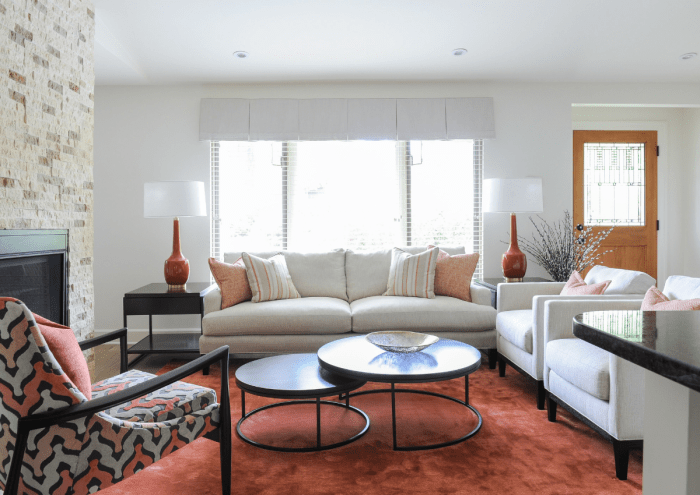Home decoration using statement pieces – is a dynamic way to bring personal style into your living space. Statement pieces serve as bold, unique items that capture attention and reflect the individuality of the homeowner. They can be iconic furniture, eye-catching artwork, or standout design elements that transform the entire aesthetic of a room. When selected and placed thoughtfully, statement pieces become the heart of your decor, creating a memorable atmosphere that speaks to your tastes.
In this 1500-word guide, we will explore the importance of statement pieces in home decor, the selection process, and how to best incorporate them into your space. Additionally, we’ll discuss creative ideas for placement and styling, ensuring that your home becomes both stylish and uniquely yours.
Understanding Statement Pieces in Home Decor
Statement pieces are more than just decorative objects—they are powerful design elements that define the character of a room. They are bold, striking, and often the first thing a visitor notices when entering your space. The purpose of a statement piece is to draw the eye, set the tone for the room, and express something about your personality or aesthetic preferences.

Whether it’s an oversized mirror, a vibrant piece of artwork, a dramatic chandelier, or an intricately designed armchair, statement pieces can completely elevate the atmosphere of a room. By anchoring your decor around these key items, you create a focal point that shapes the overall design, allowing other elements in the room to complement and enhance the look.
The Importance of Statement Pieces
The significance of statement pieces lies in their ability to transform a space from bland to extraordinary. Without them, a room can feel uninspired or generic. Statement pieces break the monotony and inject character into your living space. They add drama, uniqueness, and often act as conversation starters.
For example, an iconic furniture piece like the Eames Lounge Chair or a vintage chandelier can take a simple room and turn it into a sophisticated, visually captivating space. Similarly, an abstract painting or a large-scale sculpture can infuse your home with artistic flair, creating an atmosphere that feels curated and personal.
Incorporating statement pieces into home decor is also an opportunity to express your individuality. Every piece you select tells a story about who you are—whether you lean toward modern minimalism, rustic charm, or eclectic vibrancy, your choice of statement items reflects your taste and preferences.
Choosing the Right Statement Pieces: Key Considerations
Selecting the right statement pieces for your home requires careful thought and consideration. Here are some important factors to keep in mind when choosing these focal elements:
1. Personal Style and Preferences
Your statement pieces should be an extension of your personality. Do you prefer bold colors, clean lines, or vintage aesthetics? Whether you’re drawn to contemporary designs, mid-century modern pieces, or bohemian accents, your selections should resonate with your taste. Take time to identify the colors, textures, and materials that make you feel inspired, and look for statement pieces that align with these preferences.
For example, if you enjoy vibrant, eclectic spaces, a colorful abstract painting or an intricately patterned area rug could be the perfect choice. If your style leans more minimalist, a sleek, modern sculpture or a monochromatic oversized sofa might serve as your statement piece.
2. Scale and Proportion
Statement pieces should be proportional to the size of the room. Large pieces can overwhelm small spaces, while small pieces may get lost in large, open areas. It’s essential to consider the scale of the item in relation to the room’s dimensions. In a spacious living room, a large sofa or a bold chandelier can fill the space effectively. In a smaller room, an oversized artwork or mirror can create the illusion of more space without crowding the area.
For instance, in a large open-plan living room, a substantial dining table or a dramatic floor-to-ceiling bookshelf could serve as the room’s central focus. Conversely, in a smaller bedroom or study, a bold armchair or a striking light fixture might be a better fit, providing impact without overwhelming the space.
3. Color and Material Harmony
When choosing a statement piece, it’s important to consider how its color and material will interact with the rest of your decor. A statement piece doesn’t have to match everything else in the room, but it should complement or contrast in a way that feels intentional. For example, a vibrant red sofa can make a bold statement in a room with neutral walls, while a metallic coffee table can add a touch of glamour to an otherwise understated space.
Color harmony doesn’t mean everything needs to be the same shade, but rather, the colors should work together to create a cohesive look. You might opt for a statement piece in a complementary color to your existing decor, or choose a piece that adds a pop of contrast for a more dramatic effect.
4. Timeless vs. Trendy
When selecting statement pieces, consider whether you want something timeless or something trendy. Timeless pieces like a well-crafted leather sofa, a marble dining table, or a classic piece of artwork will endure changing styles and continue to feel relevant in years to come. Trendier items, like a velvet sofa in a bold hue or a geometric light fixture, may feel fresh and exciting now but could look dated in a few years.
There’s no right or wrong answer—it depends on how frequently you plan to update your decor. If you love to refresh your space every few years, trendy statement pieces can be a fun way to experiment. However, if you prefer to invest in items that will stand the test of time, opting for classic designs is a wise choice.
Placement and Arrangement of Statement Pieces
Where you place your statement pieces is just as important as the pieces themselves. The right placement can enhance the visual impact of the piece and create a well-balanced, cohesive look throughout the room.
1. Focal Point Creation
A statement piece should be placed in a location where it will naturally draw attention. This could be the center of the room or along a main wall where the eye naturally falls when you enter the space. For example, in a living room, the sofa often acts as the focal point, so placing a bold, uniquely designed sofa can set the tone for the entire space.
In a dining room, the dining table is typically the focal point, so a statement table or a dramatic chandelier above it can create a stunning visual effect.
2. Visual Balance
It’s important to ensure that your statement pieces are placed in a way that maintains balance within the room. If all your bold items are clustered on one side, the room can feel lopsided. Try to distribute statement pieces throughout the space, or use them to create a sense of symmetry or deliberate asymmetry.
For example, if you have a large, bold piece of artwork on one wall, you might balance it out with a statement light fixture or a striking piece of furniture on the opposite side of the room.
3. Grouping and Layering
Statement pieces don’t always have to stand alone—they can be grouped or layered with other items to create an even more dynamic visual effect. For instance, a bold coffee table can be layered with interesting decor objects, or a large mirror can be surrounded by smaller pieces of artwork to create a gallery wall effect.
By experimenting with different arrangements, you can create a more intricate and layered look that enhances the overall style of your space.
Combining Statement Pieces with DIY Elements
Incorporating DIY elements into your decor is another way to add personality and individuality to your space. DIY projects such as hand-painted artwork, custom shelving, or even repurposed furniture can add a personal touch that complements your statement pieces. The combination of professionally designed items and personal DIY projects creates a more curated and unique space.
For example, you might pair a statement lighting fixture with a DIY gallery wall or place a bold armchair next to a custom-built side table. These combinations allow you to express creativity and craft a space that is truly one-of-a-kind.
Conclusion: The Art of Home Decoration with Statement Pieces
Home decoration with statement pieces is about more than just filling a room with furniture—it’s about creating an environment that reflects who you are. By carefully choosing bold, impactful items that resonate with your style, and thoughtfully placing them in key locations, you can transform your home into a space that feels both stylish and personal.
Whether you’re investing in timeless pieces or experimenting with the latest trends, statement pieces allow you to tell a story through your decor. And by combining them with DIY elements or more understated pieces, you can create a space that’s uniquely yours—one that feels both curated and lived-in, stylish and inviting.
With the right statement pieces, your home can become a true reflection of your personality, offering a welcoming and inspiring environment for both you and your guests.




